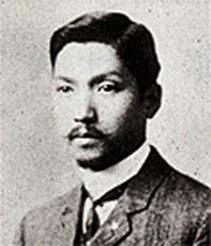Ōsugi Sakae
Japanese anarchist (1885–1923) From Wikipedia, the free encyclopedia
Ōsugi Sakae (大杉 栄, January 17, 1885 – September 16, 1923) was a prominent Japanese anarchist[1] who was jailed multiple times for his writings and activism. He was murdered alongside his partner, Itō Noe, in what became known as the Amakasu Incident.
Biography
Summarize
Perspective
Ōsugi was born on January 17, 1885. He was raised in Tokyo and Sendai. During Ōsugi's early youth, his father fought in the First Sino-Japanese War. As a teenager in military school, he was disciplined—likely for homosexual activity—and later expelled after a fight. In 1902, he returned to Tokyo.[2] His mother died later that year. He began to experiment with Christianity, associate with the Heimin-sha socialist group, and attend foreign language school.[3]
After graduating from foreign language school, Ōsugi was arrested during a Tokyo trolley fare increase demonstration in 1906 and later released on bail. He married Hori Yasuko and became an Esperanto teacher. The same year, his writing began to attract attention. He edited Katei zasshi and was charged by the government for writing "Shimpei shokun ni atau" and "Seinen ni uttau". He spent part of 1907 in jail and returned twice in 1908, for the Rooftop Incident and the Red Flag Incident.[3] His father died in 1909, while Ōsugi was in prison. After his release in 1910, he published Kindai shisō (1912–1914), Heimin Shimbun (1914–1915), and Kindai shisō again, briefly. In the same time period, he met and began affairs with Ichiko Kamichika and Itō Noe. In 1916, as Itō left her family for Ōsugi, Kamichika stabbed Ōsugi. Ōsugi was divorced by 1917 and had a daughter with Itō.[4]
Ōsugi briefly published Bummei hihyō and Rōdō shimbun in 1918, and Rōdō undō from 1919 to 1920 (and again in 1921). He was briefly jailed in-between for hitting a police officer and his second daughter was born.[5] He would have two more daughters, in 1921 and 1922. Ōsugi went to Shanghai in 1920 for the Congress of Far Eastern Socialists, to Osaka in 1922 to found a national labor union, and to Berlin in 1923 for the International Congress of Anarchists. However, before he could attend, he was arrested in a St. Denis May Day demonstration and deported. Several months after returning to Japan, he was murdered alongside Itō and his nephew in the Kantō Massacre aftermath of the September 1923 Great Kantō earthquake.[6] This crime became known as the Amakasu incident.[7]
In June 1920 Osugi was contacted by the Korean Yi Ch'un-Suk, who persuaded him to come to Shanghai and meet with Asian Communists involved with the Far Eastern Bureau of the Comintern.[8]
Director Kiju Yoshida made Eros + Massacre (エロス+虐殺) in 1969, about Ōsugi's life.[9]
See also
References
Bibliography
Further reading
External links
Wikiwand - on
Seamless Wikipedia browsing. On steroids.

